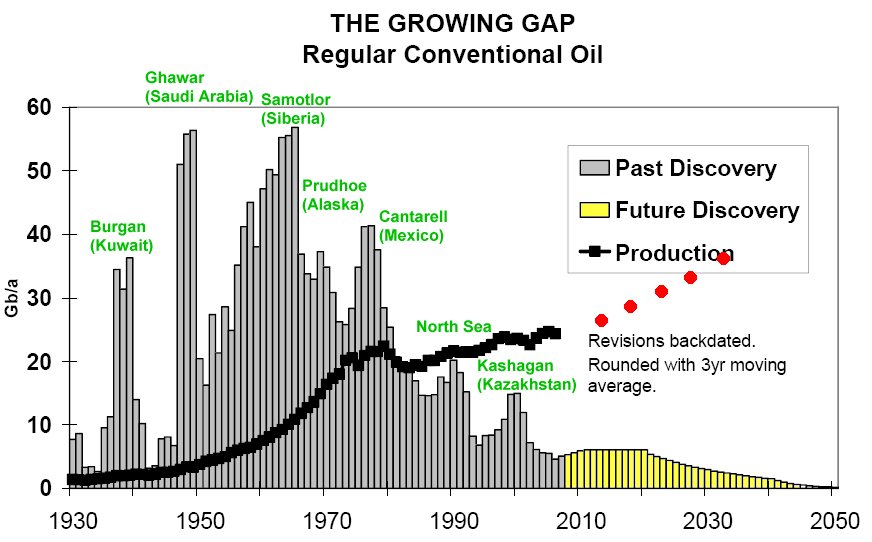skip to main |
skip to sidebar
The Growing gap
- This graphic is worth careful study.It shows oil discoveries and oil consumption since 1930 to 2008. The black line shows oil consumption. Notice the peak in consumption in 1979 corresponding to the first oil crisis. The subsequent 5 year decline in oil consumption is attributed to more fuel efficient transportation and a slowing world economy. The grey bars show oil discoveries. Notable grey bar features include Kuwait's big oil field, Burgan, which was discovered in the late 30s and Ghawar, the world's largest oil field, which was discovered in 1948. Note that the discovery rate peaked around 1966. Note also that consumption exceeds discoveries every year since 1984. Now there is a large gap between discoveries and production. None of this is controversial--it is only history.
-

- What happens after 2008 is extrapolation and speculation. The EIA (Energy Information Agency) has projected a 1.6% annual growth in oil demand which is shown in red. Developed countries, for example the USA, Germany and Japan are not expected to increase consumption. In fact, consumption might decrease because of efficiency gains. But China and India both have booming economies. Automobile ownership increased by 37% in China and 17% in India in 2007.
- The yellow bars represent a guess about yet-to-find oil. The yellow bars show no declines in the discovery rate until 2021. That seems optimistic given the declining discovery rate in the previous decade.
- Note the growing gap between discoveries and production!
The Conclusion
- Oil discovered 40 years ago is the basis of current oil production. The search for oil continues but projected oil discoveries will contribute little to projected oil production in 2030. The declining rate of oil discoveries makes it painfully obvious--most of the oil has already been discovered. The technology for finding oil has improved greatly since the major discoveries, yet little oil has been found in recent years. THe heyday of oil discovery was from 1950 to 1980. It is difficult to avoid the conclusion--most of the oil has been found.
- There is a growing gap between discoveries and production.
- World oil production is running flat out. Only the Saudis claim to have the ability to produce more though some dispute this. It is not a simple matter of turning a spigot or pumping faster. Oil fields can be permanently damaged by attempting to produce too fast.
- Soon there will be a gap between production and demand.
It Gets Worse
- According to BP (British Petroleum) world oil reserves stand at 1238 billion barrels. At present (2008) yearly world oil production stands at 31 billion barrels. There is enough oil to last 40 years if production holds constant and no new oil is found. According to BP, the Middle East has 61% of the world's oil reserves. Africa has 9.6% and the Russian Federation has 6.4%. The two countries sharing borders with the United States, Mexico and Canada, together have only 3.2%. Venezeula, a short distance away via oil tanker, has 7%
- The United States possesses 2.6% of the worlds oil reserves while it consumes 24% of the world's oil production.
- Although the United States has only 2.4% of the world's oil, it produces 9.2%. If the production rate could be maintained, the oil will be gone in 11 years. The figures for Canada are the same and they are worse for Mexico. The Middle East has enough oil to last 88 years at present production rates. Africa has 33 years. Clearly the United States will be increasingly dependent on oil imported from those places. It is impossible to consider oil independence in light of these numbers.
- The majority of the world's oil comes from old oil fields. For example, Kuwait still supplies 3% of the world's oil from a 70 year old field. The world's largest oil field, Ghawar, a 57 year old oil field, still supplies 5% of the world's oil. The North Sea (discovered in 1963) was exploited very quickly and is now in steep decline. Alaska's Prudhoe Bay (discovered in 1968) is now a trickle.
- Oil varies greatly in quality. Some oil is so light and sweet (low in sulfur) it can be pumped directly into the fuel tank of a Diesel truck. Some oil is more like tar and it may contain sulfur. It's hard to transport and natural gas may be needed to refine it into useful fuel. The oil from Manifa, a large oil field in Iran, is an extreme example. It contains so much sulfur and vanadium it can't be refined using today's technology. The average quality of oil is declining because the best quality was produced first.
- Oil varies greatly in accessibility. It is convenient to access Kuwaiti oil. Oil tankers in the Persian Gulf load from nearby Kuwaiti oil wells. It is inconvenient to access oil from the north slope of Alaska. It was necessary to build an 800 mile pipeline over mountains and permafrost to reach the oil in Prudhoe Bay. Oil drilling platforms can reach oil in mile deep water but only at great expense in money terms and in energy terms. There is oil in the arctic but oil drilling platforms will have to deal with ice and deep water to access it.
- The remaining oil will be expensive and difficult to produce, refine and transport.


Oil crises is a big problem these days & some steps should be taken
ReplyDeleteEnergy conservation is the key. Energy conservation will prolong the fossil energy that now exists. The new sustainable energy sources will not be as convenient or as abundant. Therefore energy conservation will be necessary with the sustainable energy sources in any case.
ReplyDeletesource(http://planetforlife.com/transition/index.html)
The research work is appreciable. I suggest that it should be further studied by taking this work as baseline. this work has a great importance in the modern era. According to my views, it should be highly appreciated by the seniors as well.
ReplyDeleteThere should be alternatives of oil so that we can overcome the oil crisis in the world.
ReplyDelete